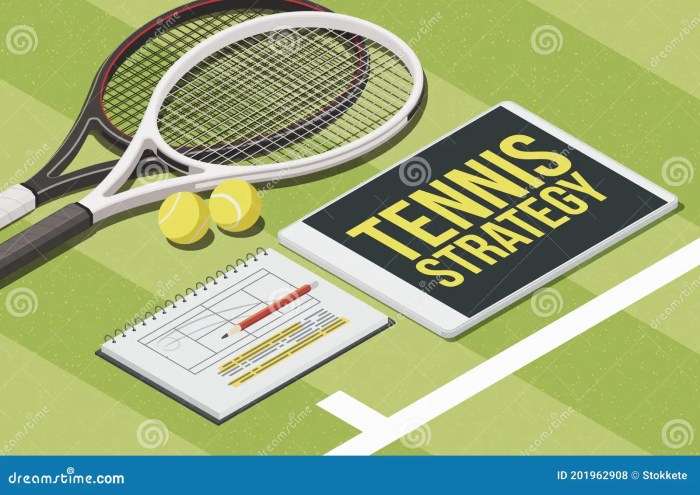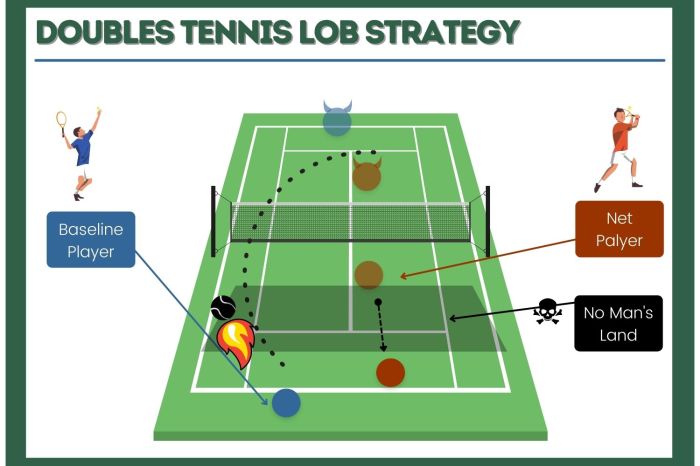Tennis strategies take the court by storm, offering a playbook of game-changing moves. From serving to net play, these tactics are the keys to victory in every match.
As you dive deeper into the world of tennis strategies, you’ll uncover a treasure trove of techniques to outsmart your opponents and dominate the game.
Basic Tennis Strategies

Tennis strategies are the game plans and tactics that players use to outsmart their opponents on the court. These strategies involve a combination of shot selection, court positioning, and mental focus to gain an advantage during a match.
Importance of Having a Strategy
Having a strategy in tennis matches is crucial for success. It allows players to anticipate their opponent’s moves, exploit their weaknesses, and play to their own strengths. Without a strategy, a player may struggle to adapt to changing circumstances during a match and may find themselves at a disadvantage.
Difference Between Offensive and Defensive Strategies
– Offensive strategies focus on putting pressure on the opponent by taking control of the point through aggressive shot-making and attacking the net.
– Defensive strategies, on the other hand, involve retrieving difficult shots, staying in the point, and waiting for the opponent to make an error before going on the offensive.
Serving Strategies: Tennis Strategies
When it comes to tennis, serving strategies play a crucial role in determining the outcome of a match. A well-executed serve can put you in control right from the start, while a weak serve can give your opponent the upper hand.
Different Types of Serves
- Flat Serve: A powerful serve that travels fast and straight, making it difficult for the opponent to return.
- Slice Serve: A serve with sidespin that curves away from the opponent, creating an angle for a more challenging return.
- Kick Serve: A high-arching serve that bounces up high, making it hard for the opponent to attack.
Significance of Varying Serve Placement and Speed, Tennis strategies
The placement and speed of your serves can keep your opponent guessing and off balance. By mixing up your serves, you can disrupt their rhythm and force errors. Serving wide can open up the court, while serving down the T can catch them off guard.
Strategic Serving Techniques
One strategic serving technique is the body serve, aimed directly at the opponent’s body to jam them up and limit their range of motion.
Another effective technique is the serve and volley, where you follow up a strong serve by rushing to the net to put pressure on your opponent.
Return Strategies

Having a strong return strategy in tennis is crucial for gaining an advantage over your opponent. A well-executed return can put pressure on the server, disrupt their rhythm, and potentially lead to winning points.
When it comes to different types of serves, such as flat, slice, kick, or topspin serves, players need to adapt their return strategies accordingly. Each serve type presents its own challenges and opportunities for the returner.
Types of Serves and Corresponding Return Strategies
- Flat Serves: When facing a flat serve, players should be prepared to react quickly and take the ball early. A good strategy is to block the return back deep and aim for the server’s feet to limit their options for the next shot.
- Slice Serves: Against a slice serve, players can use a slice return to neutralize the spin and keep the ball low over the net. This can force the server to hit up on the ball, opening up opportunities for the returner.
- Kick Serves: Dealing with a kick serve requires players to adjust their position and timing. One effective strategy is to step back and give yourself more time to track the ball’s bounce, allowing for a controlled and well-placed return.
- Topspin Serves: Topspin serves can be challenging to handle, but players can use the incoming spin to their advantage. By brushing up on the ball and adding your own topspin, you can counter the server’s spin and dictate play from the start.
Exploiting Opponent’s Weaknesses
Strategic returns can also be used to exploit weaknesses in your opponent’s serve. By identifying patterns in their serves, such as predictable placement or pace, players can anticipate the ball’s trajectory and position themselves for a more aggressive return.
Remember, a good return strategy not only puts pressure on the server but also sets the tone for the rest of the point. By being proactive and adaptable in your returns, you can gain a competitive edge on the court.
Net Play Strategies
Net play in tennis strategy involves moving closer to the net to put pressure on your opponent and control the pace and direction of the match. It can be an effective way to finish points quickly and take control of the game.
Effective Net Play Strategies
- Volleys: Practice your volley technique to be able to finish points at the net quickly and efficiently.
- Approach Shots: Use approach shots to set yourself up for a volley at the net, putting pressure on your opponent.
- Poaching: In doubles matches, poaching involves moving quickly at the net to intercept your opponent’s shot and put them on the defensive.
Using Net Play to Control the Match
- Force Errors: By moving to the net, you can force your opponent to make more difficult shots, increasing the chances of errors.
- Dictate Play: Net play allows you to dictate the pace of the match, putting pressure on your opponent and controlling the flow of the game.
- Closing Out Points: By finishing points at the net, you can close out games quickly and efficiently, putting yourself in a position of control.

